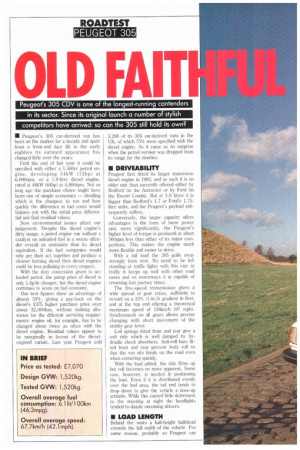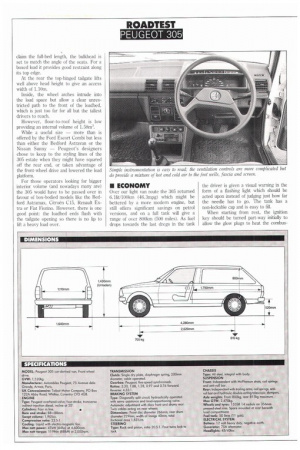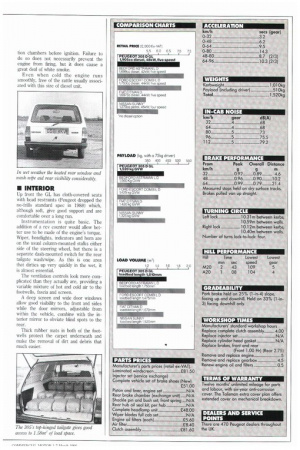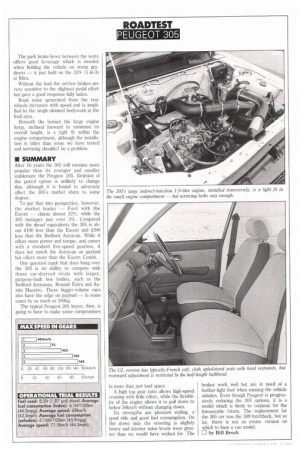OLD FA
Page 34

Page 36

Page 37

Page 38

If you've noticed an error in this article please click here to report it so we can fix it.
Peugeot's 305 CDV is one of the longest-running contenders in its sector. Since its original launch a number of stylish competitors have arrived: so can the 305 still hold its own?
• Peugeot's 305 car-derived van has been on the market for a decade and apart from a front-end face lift in the early eighties its outward appearance has changed little over the years.
Until the end of last year it could be specified with either a 1,580cc petrol engine, developing 54kW (72hp) at 6,000rpm, or a 1.9-litre diesel engine, rated at 48kW (64hp) at 4,600rpm. Not so long ago the purchase choice might have been one of simple economics — deciding which is the cheapest to run and how quickly the difference in fuel costs would balance out with the initial price differential and final residual values.
Now environmental issues affect our judgement. Despite the diesel engine's dirty image, a petrol engine run without a catalyst on unleaded fuel is a worse offender overall on emissions than its diesel equivalent. If the fuel companies would only get their act together and produce a cleaner burning diesel then diesel engines could be less polluting in every respect.
With the duty concession given to unleaded petrol, the pump price of diesel is only 1.6p/lit cheaper, but the diesel engine continues to score on fuel economy.
Our test figures show an advantage of almost 33%, giving a pay-back on the diesel's 2375 higher purchase price over about 32,000km, without making allowance for the different servicing requirements: engine oil, for example, has to be changed about twice as often with the diesel engine. Residual values appear to be marginally in favour of the dieselengined variant. Last year Peugeot sold 3,268 of its 305 car-derived vans in the UK, of which 75% were specified with the diesel engine. So it came as no surprise when the petrol version was dropped from its range for the nineties.
• DRIVEABILITY
l'eugeot first fitted its larger transverse diesel engine in 1982, and as such it is an older unit than currently offered either by Bedford (in the Astravan) or by Ford (in the Escort Combi). But at 1.9 litres it is bigger than Bedford's 1.7 or Ford's 1.75litre units, and the Peugeot's payload subsequently suffers.
Conversely, the larger capacity offers advantages in the form of more power and, more significantly, the Peugeot's higher level of torque is produced at about 500rpm less than either of its major competitors. This makes the engine much more flexible and easier to drive.
With a full load the 305 pulls away strongly• from rest. No need to be left standing at traffic lights with this van: in traffic it keeps up well with other road users and on motorways it is capable of returning fast journey times.
The five-speed transmission gives a wide spread of gear ratios, sufficient to restart on a 33% (1-in-3) gradient in first, and at the top end offering a theoretical maximum speed of 156km/h (97 mph). Synchromesh on all gears allows precise changing with short movement of the stubby gear lever.
Coil springs fitted front and rear give a soft ride which is well damped by hydraulic shock absorbers. Anti-roll bars fitted front and rear prevent body roll so that the van sits firmly on the road even when cornering quickly.
With the load added, the ride firms up but roll becomes no more apparent. Some care, however, is needed in positioning the load. Even if it is distributed evenly over the bed area, the tail end tends to drop down to give the vehicle a nose-up attitude. While this caused little detrement to the steering at night the headlights tended to dazzle oncoming drivers.
• LOAD LENGTH
Behind the seats a half-height bulkhead extends the full width of the vehicle. For some reason, probably so Peugeot can claim the full-bed length, the bulkhead is set to match the angle of the seats. For a boxed load it provides good restraint along its top edge.
At the rear the top-hinged tailgate lifts well above head height to give an access width of 1.10m.
Inside, the wheel arches intrude into the load space but allow a clear unrestricted path to the front of the loadbed, which is just too far for all but the tallest drivers to reach.
However, floor-to-roof height is low providing an internal volume of 1.58m.
While a useful size — more than is offered by the Ford Escort Combi but less than either the Bedford Astravan or the Nissan Sunny — Peugeot's designers chose to keep to the styling lines of the 305 estate when they might have squared off the rear end, or taken advantage of the front-wheel drive and lowered the load platform.
For those operators looking for bigger interior volume (and nowadays many are) the 305 would have to he passed over in favour of box-bodied models like the Bedford Astramax, Citroen C15, Renault Extra or Fiat Fiorino. However, there is one good point: the loadbed ends flush with the tailgate opening so there is no lip to lift a heavy load over.
• ECONOMY
Over our light van route the 305 returned 6.1lit/100km (46.3mpg) which might be bettered by a more modern engine, but still offers significant savings on petrol versions, and on a full tank will give a range of over 800km (500 miles). As fuel drops towards the last dregs in the tank the driver is given a visual warning in the form of a flashing light which should be acted upon instead of judging just how far the needle has to go. The tank has a non-lockable cap and is easy to fill.
When starting from rest, the ignition key should be turned part-way initially to allow the glow plugs to heat the combus tion chambers before ignition. Failure to do so does not necessarily prevent the engine from firing, but it does cause a great deal of white smoke.
Even when cold the engine runs smoothly, free of the rattle usually associated with this size of diesel unit.
Mi INTERIOR
Up front the GL has cloth-covered seats with head restraints (Peugeot dropped the no-frills standard spec in 1988) which, although soft, give good support and are comfortable over a long run.
Instrumentation is quite basic. The addition of a rev counter would allow better use to be made of the engine's torque. Wiper, headlights, indicators and horn are on the usual column-mounted stalks either side of the steering wheel, but there is a separate dash-mounted switch for the rear tailgate wash/wipe. As this is one area that dirties up very quickly in the wet, it is almost essential.
The ventilation controls look more complicated than they actually are, providing a variable mixture of hot and cold air to the footwells, fascia and screen.
A deep screen and wide door windows allow good visibility to the front and sides while the door mirrors, adjustable from within the vehicle, combine with the interior mirror to obviate blind spots to the rear.
Thick rubber mats in both of the footwells protect the carpet underneath and make the removal of dirt and debris that much easier. The park brake lever between the seats offers good leverage which is needed when holding the vehicle on steep gradients — it just held on the 33% (1-in-3) at Mira.
Without the load the service brakes are very sensitive to the slightest pedal effort but gave a good response fully laden.
Road noise generated from the rear wheels increases with speed and is amplified by the single-skinned bodywork in the load area.
Beneath the bonnet the large engine lump, inclined forward to minimise its overall height, is a tight fit within the engine compartment, although the installation is tidier than some we have tested and servicing shouldn't be a problem.
• SUMMARY
After 10 years the 305 still remains more popular than its younger and smaller stablemate the Peugeot 205. Deletion of the petrol option is unlikely to change this, although it is bound to adversely affect the 305's market share to some degree.
To put that into perspective, however, the market leader — Ford with the Escort — claims almost 32%, while the 305 manages just over 3%. Compared with the diesel equivalents the 305 is about £100 less than the Escort and £200 less than the Bedford Astravan. While it offers more power and torque, and comes with a standard five-speed gearbox, it does not match the Astravan on payload but offers more than the Escort Combi.
One question mark that does hang over the 305 is its ability to compete with those car-derived rivals with larger, purpose-built box bodies, such as the Bedford Astramax, Renault Extra and Austin Maestro. These bigger-volume vans also have the edge on payload — in some cases by as much as 200kg.
The typical Peugeot 305 buyer, then, is going to have to make some compromises in more than just load space.
A high top gear ratio allows high-speed cruising with little effort, while the flexibility of the engine allows it to pull down to below 50km/h without changing down.
Its strengths are pleasant styling, a good ride and good fuel consumption. On the down side the steering is slightly heavy and interior noise levels were greater than we would have wished for. The brakes work well but are in need of a feather-light foot when running the vehicle unladen. Even though Peugeot is progressively reducing the 305 options, it is a model which is likely to continue for the foreseeable future. The replacement for the 305 car was the 309 hatchback, but so far, there is not an estate version on which to base a van model.
by Bill Brock








































































































































